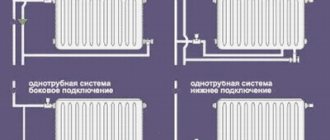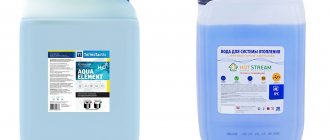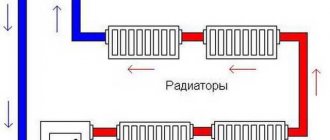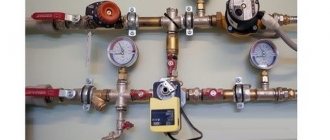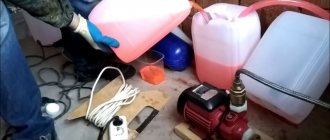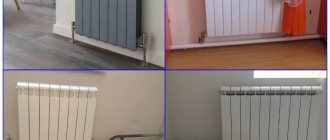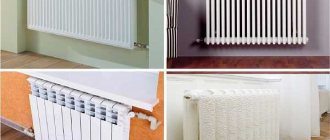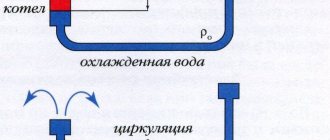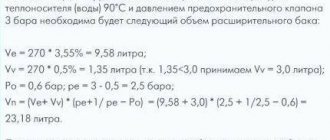The installation of a heating system (hereinafter referred to as CO) in a separate apartment or in a private house is carried out by connecting heating radiators to the main line supplying hot water coolant from an external heat source. In the designs of standard cast iron, bimetallic or aluminum batteries, threaded sockets are provided at the ends of each section for assembly connections between each other or for connecting coolant supply and removal pipelines. The figure shows a traditional cast iron radiator with the top and bottom end sockets plugged.
Cast iron heating radiator
To properly ensure the tightness of the connection of a steel or polymer heat distribution pipe to the battery, welding and threaded connections are used. The photo shows an element of a section of a cast iron radiator with a fitting for a threaded connection method.
Fitting for connecting the heating distribution pipe to a cast iron radiator
Is assembly required
If the radiators are supplied assembled, it is enough to install plugs and a Mayevsky tap. Most models have four holes located at the four corners of the body. They are used to connect heating lines. In this case, any scheme can be implemented.
Before installation of the system begins, it is necessary to close excess holes using special plugs or air vent valves. The batteries are supplied with adapters that must be screwed into the collectors of the product. In the future, various communications should be connected to these adapters.
Prefabricated models
Assembling batteries should begin by laying the entire product or its sections on a flat surface. Best on the floor. Before this stage, it is worth deciding how many sections will be installed. There are standards that allow you to determine the optimal amount.
The sections are connected using nipples having two external threads: right and left, as well as a turnkey lug. The nipples should be screwed into two blocks: at the top and at the bottom.
When assembling the radiator, be sure to use the gaskets supplied with the product.
It is necessary to ensure that the upper edges of the sections are correctly located - in the same plane. The tolerance is 3 mm.
Sequence of work
Installation of batteries begins with complete shutdown of the circuit. When replacing old radiators with new ones, the water is drained and the heating elements are dismantled. It would be correct to use a pump to eliminate the presence of coolant residues in the system.
After all the water has been removed, the mounting location of the batteries is aligned in both planes. Brackets are installed.
The next step is to pack the radiators using sealing flax, packaging paste or special shut-off valves. Using a torque wrench, tighten the connection, creating the force specified in the documentation.
Installation work
Installation of radiators on the wall is carried out by welding or polypropylene pipes. In the first case, it is enough to use two fasteners; in the second, at least three are required. Two should be at the top, one at the bottom.
With ten or more sections, the number of fastenings should be increased to five. There should be three at the top, two at the bottom.
Spatial location control
The position of the batteries is monitored in both planes. It is advisable to provide a slight slope towards the wall. This will avoid airing the system during its operation.
The final stage
Threads are cut on the risers and all elements of the heating system are connected. The tightness of all connections is carefully monitored.
Test tests can then be carried out to detect possible leaks.
If until now everything was done with your own hands, at this stage it is better to invite a housing and maintenance mechanic. By turning off the American taps, you can open the connecting tap. It is better to leave the opening of the return pipe to a mechanic.
If there are no leaks at the connection points, it will be possible to open the valve on the batteries and close the bypass valve. The coolant will begin to flow into the heating system. To bleed air, you should use the Mayevsky tap.
Once the heating circuit in all rooms has warmed up, the plumber will open the straight pipe. This will restore pressure in the system. The control tests can be considered completed. If the installation was done correctly, the apartment will be comfortable at minimal cost.
Disadvantages and advantages
You have to wait a long time.
First, let's talk about the shortcomings. This approach will help you decide whether such a heating system is right for you.
- If the system does not have a pump, then you need to wait quite a long time until the hot water reaches the radiators and passes through them.
- Uneven heating of heating radiators. This is due to the same nuance - hot water on top and cold water below.
- Installation is carried out using more expensive large diameter pipes.
- It is necessary to install an open expansion tank, as a result of which water evaporates and must be periodically added to the system. Installing a closed expansion tank may impair system performance.
- The design of the room suffers.
- The slope of the pipes must not be disturbed, even if it is necessary to bypass the doors.
- The system should have as few turns as possible.
- When planning a heating system without a pump, you need to correctly determine the level of location of the batteries, expansion tank and boiler, which should be installed at the lowest point.
Advantages
- Electrical independence. Even if a pump is installed, if there is a power outage (or if the pump fails), the heating system continues to operate.
- Installation and further maintenance do not require special skills.
- Quiet operation.
Signs of a poorly maintained heating system
For the normal functionality of the heating system, nothing should interfere with the movement of the coolant through the channels constructed for it.
There are several symptoms that a large amount of debris has accumulated inside the heating circuit, and scale has settled on the walls of the pipes. There are no obvious visual signs of clogging of the heating system.
It can be diagnosed by carefully monitoring the operation of the entire system and the appearance of a number of indirect signs:
- warming up of the system takes longer than before (for autonomous heating systems);
- the operation of the boiler is accompanied by uncharacteristic sounds;
- increased gas or electricity consumption; the temperature in different parts of the radiators varies significantly;
- radiators are noticeably cooler than supply pipes.
However, weak or uneven heating of batteries is not always a sign of clogging. Perhaps they were aerated. In such a situation, it is enough to reset the air lock through the Mayevsky tap.
In houses with a central heating system, its flushing should be carried out by employees of the heat supply company. In a private home, this procedure is carried out by the owners or invited specialists.
It is difficult to unequivocally recommend the frequency of flushing the system. There are too many factors influencing this.
For example, in centralized heating systems, the coolant must undergo a water treatment cycle, which reduces the degree of contamination. True, this rule is not always followed. And the system itself is often in its third or fourth decade of operation, and the amount of waste circulating inside increases every year.
But for both centralized networks and autonomous systems, it is recommended to flush annually. Which, by the way, is confirmed by the requirements of building codes. This period is considered critical for the accumulation of debris inside the circuit, which significantly reduces operating efficiency.
Classification by type of coolant circulation
According to the method of creating liquid circulation, private heating systems are divided into two types: gravity (with natural circulation) and pumping (with forced movement).
Before installation, you should take into account the operating principles of each equipment and select the most suitable one for the building conditions.
Natural circulation systems
The natural movement of water is caused only by physical processes. Liquid moves under pressure.
With the correct layout of such a system, heating will depend only on the natural water pressure. Failures, if all conditions are met, are extremely rare.
With forced circulation
If the building is built in an area with unstable water levels, experts recommend installing equipment with forced circulation. A special pump is built in to ensure constant movement of the coolant.
It requires an electrical connection to function. When there is a power outage, the entire system may fail.
Rules for installing heating radiators
Length requirements are not all recommendations. There are also rules for location under the window relative to the floor, window sill and wall:
- The heating device must be located strictly in the middle of the window opening. When editing, find the middle and mark it. Then to the right and left you set the distance to the location of the fasteners.
- The distance from the floor is 8-14 cm. If you make it smaller, it will be difficult to clean; if you make it more, zones of cold air will form below.
- The radiator should be 10-12 cm away from the window sill. With a closer location, convection worsens and thermal output decreases.
- The distance from the wall to the back wall should be 3-5 cm. This gap ensures normal convection and heat distribution. And one more thing: at a short distance, dust will settle on the wall.
Based on these requirements, determine the most suitable radiator size, and then look for a model that satisfies them.
Mounting methods depending on the type of wall
These are general rules. Some manufacturers have their own recommendations. And take it as advice: before purchasing, carefully study the installation requirements. Make sure that all conditions suit you. Only then buy.
To reduce non-productive losses - due to heating the wall - attach foil or a thin foil heat insulator behind the radiator on the wall. This simple measure will save 10-15% on heating costs. This is how much heat transfer increases. But keep in mind that for normal “work,” there must be a distance of at least 2-3 cm from the shiny surface to the back wall of the radiator. Therefore, the heat insulator or foil must be fixed to the wall, and not just leaned against the radiator.
When should radiators be installed? At what stage of system installation? When using radiators with side connections, you can first hang them, then start laying out the pipeline. For the lower connection the picture is different: you only need to know the center-to-center distance of the pipes. In this case, radiators can be installed after the repair is completed.
To increase heat output, attach foil to the wall
Features of installation of various types
The material from which a particular heating element is made imposes certain requirements for its installation. While cast iron is not afraid of serious mechanical stress, others require special care.
Cast iron classic
Cast iron radiators are still relevant. The special characteristics of the material used in their manufacture make it possible to effectively heat a room of any size due to slow cooling.
To install such a heating element correctly, before connecting you should:
- disassemble the finished product into sections;
- Having pulled out all the nipples, assemble the product in the reverse order.
When performing installation work, it is worth taking into account the weight of the product and the composition of the material from which the house was built. The heating element can only be installed on brick and concrete walls. The battery is installed near a plasterboard wall on a floor stand.
Modern models
Such products are characterized by low weight and increased fragility. For them it is necessary to provide a Mayevsky crane.
During installation work, do not remove the packaging to prevent surface deformation.
We make a calculation
The formula by which heat transfer is calculated is as follows:
Q = K*F*dT, where
- K – thermal conductivity coefficient of steel;
- Q – heat transfer coefficient, W;
- F is the area of the pipe section for which the calculation is being made, m 2 dT is the value of the temperature pressure (the sum of the primary and final temperatures taking into account room temperature), ° C.
The thermal conductivity coefficient K is selected taking into account the area of the product. Its size also depends on the number of threads laid in the premises. On average, the coefficient is in the range of 8-12.5.
dT is also called temperature difference. To calculate the parameter, you need to add the temperature that was at the outlet of the boiler with the temperature that was recorded at the entrance to the boiler. The resulting value is multiplied by 0.5 (or divided by 2). The room temperature is subtracted from this value.
dT = (0.5*(T 1 + T 2)) - T to
If the steel pipe is insulated, then the resulting value is multiplied by the efficiency of the insulating material. It reflects the percentage of heat that was given off during the passage of the coolant.
Best answers
President of Russia:
To put it simply: Process water is water used by enterprises for technological purposes. Its difference from drinking water is that the requirements for impurities and bacteria for drinking water are higher than for technical water. Example. Process water is water in heating systems. This water contains various technological impurities. For this water, waste and sewer water can be used after their technical purification (bacteriological purification is also possible, as well as special chemical compositions to prevent defrosting of heating systems. The use of industrial water as drinking water and for contact with products and other types of human activity is not allowed. If use and is allowed for irrigation, flushing (sewage), then a chemical and bacteriological analysis of this water must be carried out. Non-chlorinated industrial water at temperatures from 20 to 40 degrees is especially dangerous. All bacteria are actively developing in this water - deadly to human life. Swimming in such water is deadly, as it is possible to become infected with tuberculosis, dysentery, meningitis, etc.
Kenshi Hemuro:
Tell us in more detail what kind of industrial water this is? In any case, you definitely shouldn't drink it.
Evgeniy Zemenkov Larisa Blikova:
She lived in a rented house. The water from the well was very hard. I threw the car away. The filters were changed 2 times in six months. Now, I think they are throwing out all the taps and mixers there.
MamaIra:
Hot technical water flows from our tap, of course you can’t drink it, but you can wash and do laundry.
Echidna:
I don’t think you have much of a choice. You won’t filter the water separately for each wash.
Valery Ivanov:
if process water is groundwater, then you can do anything in it
NICOLE:
and we drink at work, we just boil it first
Radiator installation
Heating radiator connection diagrams.
Before starting work, you need to completely shut off the heating circuit, then drain the water from the system, the remains of which can be carefully removed by a pump. The radiator mounted on supports is checked horizontally and vertically using a level.
It is necessary to unscrew all plugs from the device. Connect a bypass equipped with a valve, which is required only for a single-pipe circuit. To connect to a two-pipe circuit, a bypass is not required; only a squeegee with a valve connected to it is used for connection. Using threaded fittings, connect the radiator to the system; to seal the joints, tow or other sealant is used.
The installation is complete, but proper crimping will still be required. To do this, you will need to call a plumber. And there is no point in buying a device just to install several batteries. How to properly install a cast iron battery?
Installation diagram of heating radiators.
The material, which does not please with grace, retains heat for a long time and gradually transfers it to the heated space. For those who want to know how to properly install a heating radiator, which is made of heat-intensive cast iron, here are the specific design features of the device and its installation:
Before installation, a cast iron radiator must be unscrewed, the nipples adjusted, and then the radiator must be reassembled. Disassembly is carried out on a workbench using a pair of radiator keys, which are inserted into the nipple holes. In order to increase the applied force and to fix it, a crowbar is inserted into the eye of the key, which is designed to unscrew the lower nipple. In order to avoid distortion, both nipples, which are located at the top and bottom, are unscrewed at the same time. It will be more convenient to do the work together
When unscrewing a cast iron radiator, you must pay attention to the direction of the thread. On different sides of a cast iron radiator, the threads have the opposite direction
Next, remove the section; By analogy, you need to screw together all the sections, and then, in strictly reverse order, you need to correctly group them into a single device with the required number of sections to heat the room. The assembled battery is pressurized, and if a leak is detected, the nipple is adjusted in the problem area; wall-mounted cast iron radiators are fixed on brick and foam concrete walls. Wooden walls cannot support weight, so the owner of a wooden house will need to install batteries with special floor supports. But it is also necessary to install supporting fasteners on the walls; Since in private houses heating is mainly single-pipe, it is necessary to install a bypass. In the connection diagram, you need to install a Mayevsky tap and the corresponding shut-off valves; connection to the pipeline is made using threaded fittings. It is better not to use a welding machine in wooden buildings.
There is not a single particularly difficult moment in the installation technology. If you strictly follow the sequence, know the rules, study information on how to properly install a heating radiator. then you can safely get down to business with hands that confidently hold radiator, torque wrenches and other tools. But confidence alone is not enough to achieve success. Strict adherence to installation rules and the formation of an impeccable tightness, which guarantees a complete absence of leaks, will definitely help.
How will we connect
The connection diagram for radiators may be different. The level of heat transfer and the comfort of staying in the apartment depend on which option is preferred. Incorrectly selected wiring can reduce the power of the heating system by 50%.
The most widespread is the one-sided side scheme, characterized by the highest heat transfer rate. In this case, the coolant supply pipe is connected to the upper pipe, and the outlet pipe to the lower one.
If you do the opposite, the efficiency of heating the room will decrease by almost 7%. For connecting multi-section radiators, such a scheme is not always justified, since insufficient heating of the last sections is possible. This can be avoided by installing a water flow extension.
In an apartment with pipes hidden in the floor or running under the baseboard, a bottom connection is used.
This is the most aesthetic option, in which the pipes for supplying and discharging coolant are located below in the floor, and therefore the lower holes are used for connection.
Diagonal
Batteries with twelve or more sections are installed in a diagonal pattern.
The coolant is supplied through the upper pipe located on one side of the radiator, and discharged through the lower pipe on the other side.
Sequential
This connection diagram assumes that there is sufficient pressure in the heating system for the coolant to move through the pipes.
In this case, it is worthwhile to provide a Mayevsky valve designed to remove excess air.
It is important to remember that repair and maintenance work will be accompanied by shutting down the entire heating system
Parallel
Parallel wiring assumes the presence of a special heat pipe built into the heating system, through which the coolant is supplied and discharged outside.
The presence of special taps at the inlet and outlet makes it possible to replace individual radiators without turning off the heat supply. However, the circuit may cause insufficient heating of the pipes at low pressure in the system.
Methods for installing heating equipment
The connection of all elements of the heating structure can be carried out in different ways. According to the method of installation to the main line, radiator heating systems can be:
The vertical system has a bottom-up connection. The heating elements of all floors in the building are carried to one riser. This method is effective, but expensive.
The horizontal system is used in buildings with one floor. The room usually has a large area, so the heating design must be complex. Radiators are connected along a horizontal path. The distribution of risers is placed in the corridor or entrance.
How to place batteries
First of all, recommendations concern the installation location. Most often, heating devices are installed where heat loss is the most significant. And first of all these are windows. Even with modern energy-saving double-glazed windows, it is in these places that the most heat is lost. What can we say about old wooden frames?
It is important to place the radiator correctly and not make a mistake in choosing its size: not only power is important
If there is no radiator under the window, then the cold air descends along the wall and spreads along the floor. The situation is changed by installing a battery: warm air, rising upward, prevents cold air from “draining” onto the floor. It must be remembered that in order for such protection to be effective, the radiator must occupy at least 70% of the width of the window. This norm is prescribed in SNiP. Therefore, when choosing radiators, keep in mind that a small radiator under the window will not provide the required level of comfort. In this case, there will be zones on the sides where the cold air will go down, and there will be cold zones on the floor. In this case, the window may often “sweat”, condensation will form on the walls in the place where warm and cold air collide, and dampness will appear.
For this reason, do not try to find the model with the highest heat output. This is justified only for regions with a very harsh climate. But in the north, even the most powerful sections have large radiators. For central Russia, average heat transfer is required, for southern regions, low radiators are generally needed (with a small center distance). This is the only way you can fulfill the key rule for installing batteries: blocking most of the window opening.
A battery installed near the doors will work effectively
In cold climates, it makes sense to install a thermal curtain near the front door. This is the second problem area, but it is more typical for private houses. This problem may occur in ground floor apartments. The rules here are simple: you need to place the radiator as close to the door as possible. Choose a location depending on the layout, also taking into account the possibilities of piping.
Advantages and disadvantages
Using a heating system with natural coolant circulation has many advantages, the main ones of which include:
- easy installation, commissioning and maintenance;
- maximum efficiency - the gravity heating network has a high efficiency and makes it possible to regulate the temperature regime of each room individually;
- efficiency - a gravity heating network is one of the least expensive among existing home heating systems (if measures are taken to reduce the thermal conductivity of walls, floors and roofs);
- noiselessness – the absence of operating electrical equipment minimizes the noise that accompanies the operation of the climate system;
- energy independence - a gravity heating network that has been put into operation will work even in the event of a temporary interruption in the supply of electricity, which would otherwise be needed to power the pumps;
- long service life - with proper installation and proper maintenance, heating equipment will operate for more than 35 years without the need for major reconstruction.
Gravity heating system - a guarantee of warmth and comfort in the home
The main disadvantage of heating with natural circulation is the impossibility of using it for large buildings. Due to the low liquid pressure, the length of horizontal sections of pipelines should not exceed 30-35 meters, otherwise the efficiency of the system will significantly decrease.
In addition, it is necessary to have a technical floor at the top of the building where the expansion tank is installed.
Also, due to the low inertia, it is recommended to avoid laying pipes in unheated rooms, as there is a risk of freezing of the coolant and, as a result, compromising the integrity of the pipelines.
A natural circulation system is perhaps the best solution for heating a small country house. However, it is absolutely not suitable for a city apartment, a dacha where people are not expected to live all year round and a cottage with an area of more than 100 square meters. meters. In this case, it is better to focus on other heating methods, which are described in the video below.
Taking water from batteries is prohibited and is harmful to health.
Details Created 06/06/2017
We do not have a centralized hot water supply as such, because we have an open heat supply system, that is, there is no separate boiler in the boiler room and a separate pipeline for hot water. An open hot water supply (heat supply) system is understood as a technologically connected complex of engineering structures , intended for heat supply and hot water supply, carried out by selecting hot water from the heating network. Once again I would like to remind users of heat supply services that, according to clause 35 of the Government of the Russian Federation of May 6, 2011 No. 354 “On the provision of utility services to owners and users of premises in apartment buildings in homes and residential buildings, “the use of hot water from the heating system is strictly prohibited.” Resource-supplying organizations suffer losses due to unauthorized water collection, because constant replenishment of boilers with cold water and additional fuel consumption for heating the coolant are required. According to this resolution, the Consumer does not have the right to: b) drain the coolant from the heating system without the permission of the contractor; c) arbitrarily dismantle or turn off the heating elements provided for in the design and (or) technical documentation for an apartment building or residential building, arbitrarily increase the heating surfaces of heating devices installed in a residential building above the parameters provided for in the design and (or) technical documentation for an apartment building or residential building house; d) unauthorizedly break the seals on metering devices and at the places where they are connected (attached), dismantle metering devices and carry out unauthorized interference in the operation of these metering devices; e) regulate indoor equipment used for the consumption of communal heating services; f) unauthorizedly connect consumer equipment to in-house engineering systems or to centralized networks of engineering support directly or bypassing metering devices, make changes to in-house engineering systems.
Therefore, the State Housing Inspectorate of the Republic of Khakassia recommends that owners of premises in apartment buildings not equipped with centralized hot water supply dismantle the water taps on heating appliances and install electric water heaters. If, during an inspection by housing inspectors, the presence of additional equipment for draining water from the heating system is detected, consumers face administrative liability for illegal reconstruction of residential premises under Article 7.21 of the Code of Administrative Offenses of the Russian Federation in the form of a fine of up to 1,500 rubles. And one more important point is that hot water supply must meet the sanitary and epidemiological requirements for the quality of drinking water. DHW in an open system cannot meet these requirements, since the coolant in the heating system is process water. This is confirmed by the results of an analysis of water from the heating system conducted by an accredited testing laboratory center on May 5 of this year. Here are some characteristics of battery water:
| Parameters (characteristics) | Actual figures | Standard indicators |
| Common coliform bacteria | 15 | Not allowed |
| Thermotolerant coliform bacteria | 15 | Not allowed |
| Iron | 0,95 | No more than 0.3 |
| Chroma | 75,2 | No more than 20 |
| Turbidity | 19,26 | No more than 1.5 |
Based on the above, in order to avoid unauthorized withdrawal of water from the heating system and prevent harm to the health of citizens, a special dye will be added to the heating system, which can spoil the appearance of the laundry if it is washed with such water.
Labor safety engineer of Tashtypenergo LLC Yu. V. Bocharov
What temperature in a living space are utilities required to provide?
The legislation has approved sanitary rules and regulations for almost all occasions. According to the developed documents, the following indicators have been established that service organizations are obliged to provide for residential premises:
- for rooms with external walls on both sides - corner ones - the temperature maintained by central heating should not fall below +20 °C;
- the same indicator has been approved for new buildings, no more than a year has passed since their commissioning;
- in all other cases, the room temperature should not fall below +18 °C, both in living areas and in the kitchen;
- for a bathroom, the lower limit of the norm will be higher – at +25 °C;
- on stairs and in lobbies – minimum +16 °C.
If the above standards are observed, any claims will be illegal, and even cold radiators at high heating rates will not be considered a reason for any action on the part of the organizations serving the building.
Features of installing radiators in an apartment
The given rules for installing heating radiators are general for both individual systems and centralized ones. But before installing new radiators, you must obtain permission from the management or operational company. The heating system is common property and all unauthorized alterations have consequences - administrative fines. The fact is that with a massive change in the parameters of the heating network (replacing pipes, radiators, installing thermostats, etc.), the system becomes unbalanced. This can lead to the entire riser (entrance) freezing in winter. Therefore, all changes require approval.
Types of wiring and connections of radiators in apartments (click on the picture to enlarge its size)
Another feature is of a technical nature. With a vertical single-pipe distribution (one pipe enters through the ceiling, goes to the radiator, then exits and goes to the floor), when installing the radiator, install a bypass - a jumper between the supply and discharge pipelines. Paired with ball valves, this will give you the opportunity to turn off the radiator if desired (or in an emergency). In this case, no approval or permission from the manager is required: you have turned off your radiator, but the coolant continues to circulate through the riser through the bypass (that same jumper). You don't need to stop the system, pay for it, or listen to your neighbors' complaints.
A bypass is also needed when installing a radiator with a regulator in an apartment (the installation of the regulator also needs to be coordinated - it greatly changes the hydraulic resistance of the system). The peculiarity of its operation is that it blocks the flow of coolant. If there is no jumper, the entire riser is blocked. Can you imagine the consequences...
Installing heating radiators with your own hands is not the easiest, but also not the most difficult task. You just need to take into account that most manufacturers give guarantees only if heating devices are installed by representatives of organizations that have a license to do so. The fact of installation and crimping must be noted in the radiator’s passport, the installer’s signature and the company’s seal must be on it. If you don’t need a guarantee, your hands are in place, it’s quite possible to handle it.
Lower and upper wiring diagram of autonomous circulation
Based on the type of wiring, heating circuits are divided into structures with lower and upper wiring. With lower wiring, the supply line is laid at the bottom of the coolant flow diagram, like the return pipe. Both lines are located below the heating devices. This design has high hydraulic stability and is convenient in that it allows the vertical pipes of the risers to be moved outside the rooms. With this arrangement, all circuit regulators (valves, locking mechanisms) are located in one room, usually a basement or technical floor.
Bottom distribution of heating pipes saves heat, because they are not installed in attics or ceiling spaces. The disadvantage of this type of heating is the need to install air bleed valves on each radiator, as well as constant air locks.
With the upper type of wiring, the pipeline with the coolant passes in the upper part of the heating circuit. Typically it is located in the attic or in the space between the ceiling and roof. Return pipes are installed below heating radiators. An expansion tank is placed at the highest point of the circuit. It regulates the pressure inside the structure and eliminates the occurrence of air congestion. This type of heating cannot be installed in a house where there is no roof slope. The disadvantage of the upper distribution is the negative gravitational pressure in the vertical pipes. This interferes with the flow of water and reduces hydraulic stability. With overhead wiring, it is impossible to drain the risers centrally.
In addition to the lower and upper wiring, there is also a mixed one: the supply line runs from above, and the return pipeline passes through the lower part of the heating structure. This approach is reasonable if a multi-storey building has its own autonomous boiler located under the roof.
